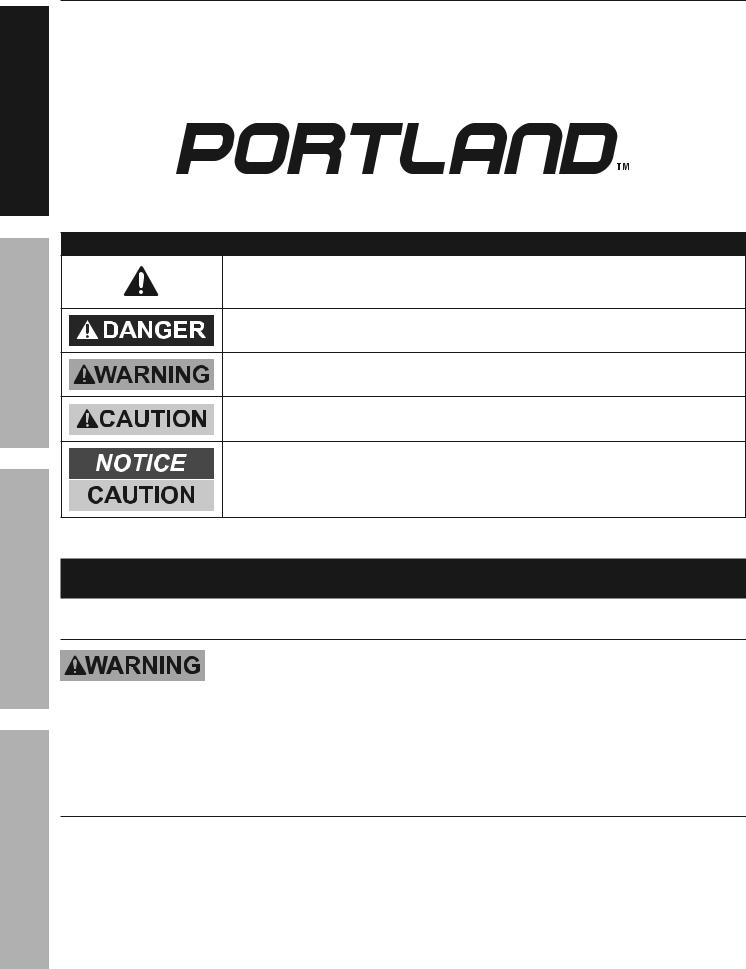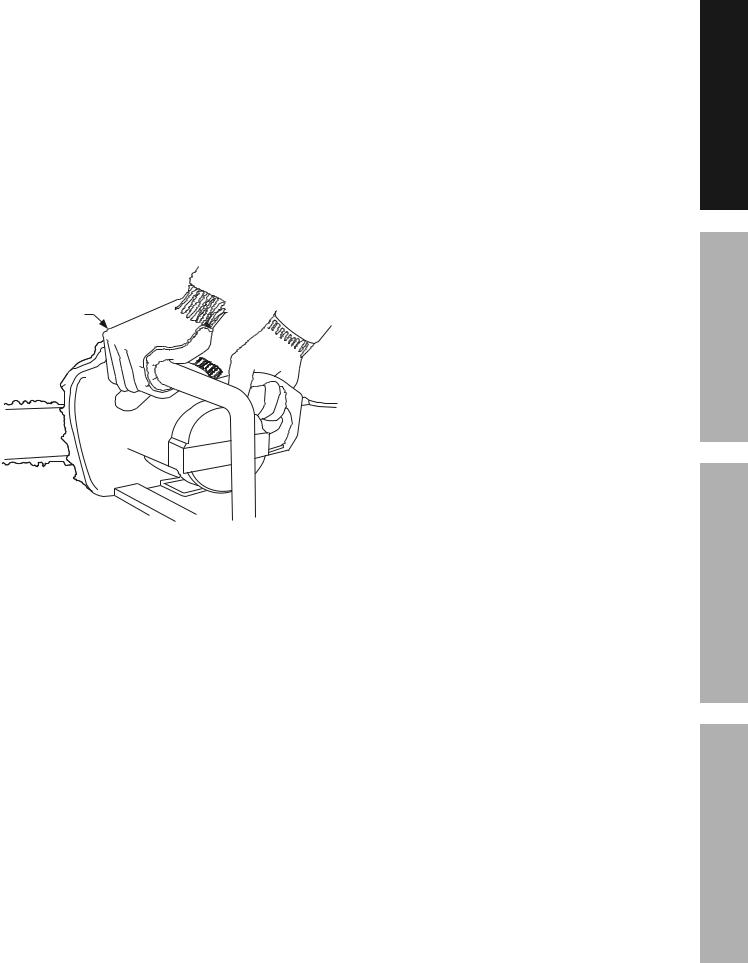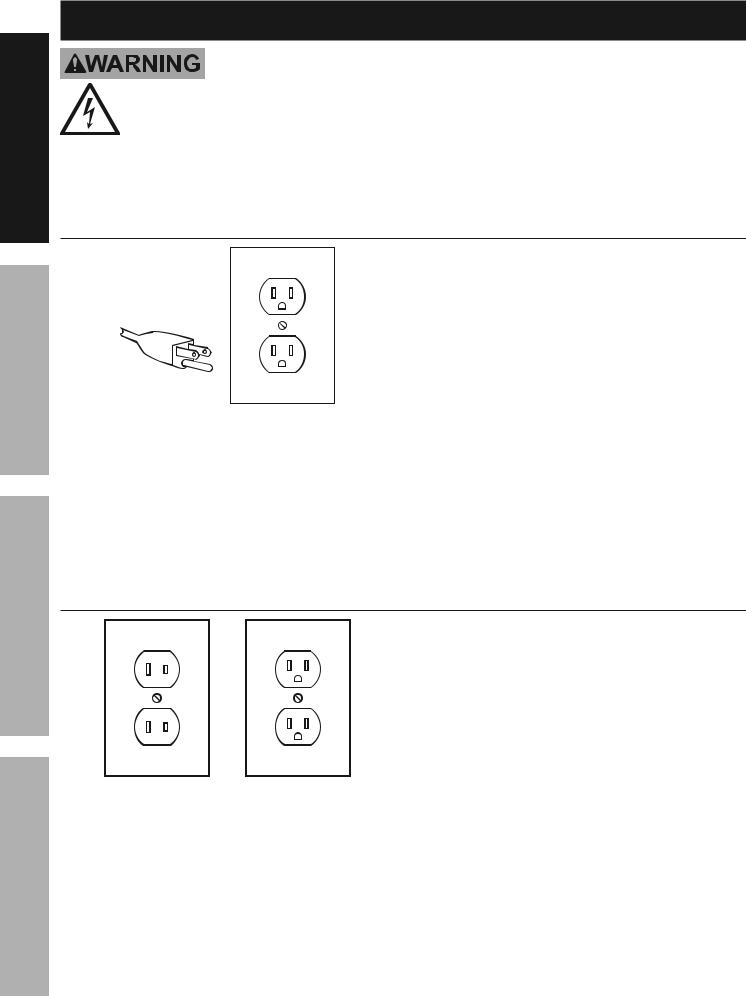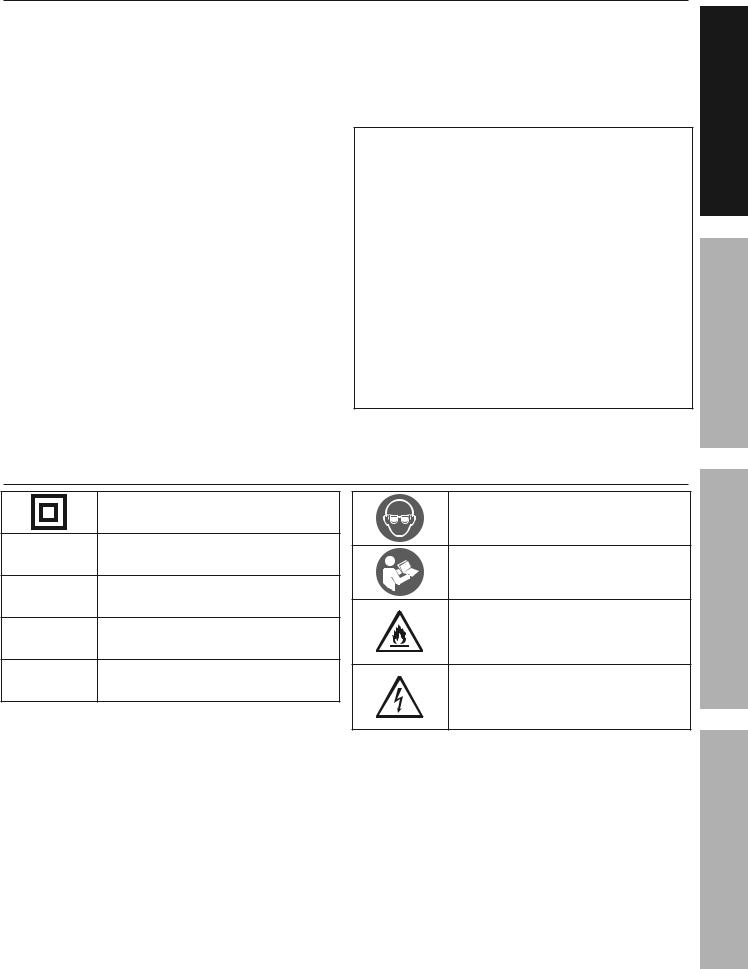Portland 64497 User Manual

Owner’s Manual & Safety Instructions
Save This Manual Keep this manual for the safety warnings and precautions, assembly, |
|
operating, inspection, maintenance and cleaning procedures. Write the product’s serial number in the |
|
back of the manual near the assembly diagram (or month and year of purchase if product has no number). |
|
Keep this manual and the receipt in a safe and dry place for future reference. |
18e |
Visit our website at: http://www.harborfreight.com
Email our technical support at: productsupport@harborfreight.com
When unpacking, make sure that the product is intact and undamaged. If any parts are missing or broken, please call 1-888-866-5797 as soon as possible.
Copyright© 2018 by Harbor Freight Tools®. All rights reserved.
No portion of this manual or any artwork contained herein may be reproduced in any shape or form without the express written consent of Harbor Freight Tools.
Diagrams within this manual may not be drawn proportionally. Due to continuing improvements, actual product may differ slightly from the product described herein.
Tools required for assembly and service may not be included.
Read this material before using this product. Failure to do so can result in serious injury. SAVE THIS MANUAL.

SaFEty
SEtup
table of contents
Safety ......................................................... |
2 |
Maintenance .............................................. |
17 |
Specifications ............................................. |
8 |
Parts List and Diagram .............................. |
20 |
Setup .......................................................... |
9 |
Warranty .................................................... |
24 |
Operation................................................... |
12 |
|
|
WarninG SyMBOLS anD DEFinitiOnS
This is the safety alert symbol. It is used to alert you to potential personal injury hazards. Obey all safety messages that
follow this symbol to avoid possible injury or death.
Indicates a hazardous situation which, if not avoided, will result in death or serious injury.
Indicates a hazardous situation which, if not avoided, could result in death or serious injury.
Indicates a hazardous situation which, if not avoided, could result in minor or moderate injury.
Addresses practices not related to personal injury.
OpEratiOn
iMpOrtant SaFEty inFOrMatiOn
General power tool Safety Warnings
MaintEnancE
read all safety warnings and all instructions.
Failure to follow the warnings and instructions may result in electric shock, fire and/or serious injury.
Save all warnings and instructions for future reference.
The term ″power tool″ in the warnings refers to your mains-operated (corded) power tool.
Work area Safety
1. Keep work area clean and well lit. |
3. Keep children and bystanders |
Cluttered or dark areas invite accidents. |
away while operating a power tool. |
|
Distractions can cause you to lose control. |
2.Do not operate power tools in explosive atmospheres, such as in the presence of flammable liquids, gases or dust. Power tools create sparks which may ignite the dust or fumes.
Page 2 |
For technical questions, please call 1-888-866-5797. |
Item 64497 |

Electrical Safety
1.power tool plugs must match the outlet. never modify the plug in any way.
Do not use any adapter plugs with grounded power tools. Unmodified plugs and matching outlets will reduce risk of electric shock.
2.avoid body contact with grounded surfaces such as pipes, radiators, ranges and refrigerators. There is an increased risk of electric shock if your body is grounded.
3.Do not expose power tools to rain or wet conditions. Water entering a power tool will increase the risk of electric shock.
4.Do not abuse the cord. never use the cord for carrying, pulling or unplugging the power tool. Keep cord away from heat, oil, sharp edges or moving parts. Damaged or
entangled cords increase the risk of electric shock.
5.When operating a power tool outdoors, use an extension cord suitable for
outdoor use. Use of a cord suitable for outdoor use reduces the risk of electric shock.
6.if operating a power tool in a damp location is unavoidable, use a Ground Fault circuit interrupter (GFci) protected supply.
Use of a GFCI reduces the risk of electric shock.
personal Safety
1.Stay alert, watch what you are doing and use common sense when operating a power tool. Do not use a power
tool while you are tired or under the influence of drugs, alcohol or medication.
A moment of inattention while operating power tools may result in serious personal injury.
2.use personal protective equipment. always wear eye protection. Protective equipment such as dust mask, non-skid safety shoes, hard hat, or hearing protection used for
appropriate conditions will reduce personal injuries.
3.prevent unintentional starting.
Ensure the trigger is in the off-position before connecting to power source, picking up or carrying the tool.
Carrying power tools with your finger on the Trigger or energizing power tools that have the Trigger on invites accidents.
4.Do not overreach. Keep proper footing and balance at all times. This enables better control of the power tool in unexpected situations.
5.Dress properly. Do not wear loose clothing or jewelry. Keep your hair, clothing and gloves away from moving parts. Loose clothes, jewelry or long hair can be caught in moving parts.
6.if devices are provided for the connection of dust extraction and collection facilities, ensure these are connected and properly used. Use of dust collection can reduce dust-related hazards.
7.Only use safety equipment that has been approved by an appropriate standards agency.
Unapproved safety equipment may not provide adequate protection. Eye protection must be ANSI-approved and breathing protection
must be NIOSH-approved for the specific hazards in the work area.
power tool use and care
1.Do not force the power tool. use the correct power tool for your application.
The correct power tool will do the job better and safer at the rate for which it was designed.
2.Do not use the power tool if the trigger does not turn it on and off.
Any power tool that cannot be controlled with the Trigger is dangerous and must be repaired.
3.Disconnect the plug from the power source before making any adjustments, changing accessories, or storing power tools.
Such preventive safety measures reduce the risk of starting the power tool accidentally.
4.Store idle power tools out of the reach of children and do not allow persons unfamiliar with the power tool or these instructions
to operate the power tool. Power tools are dangerous in the hands of untrained users.
5.Maintain power tools. check for misalignment or binding of moving parts, breakage of parts and any other condition that may affect the power tool’s operation. if damaged, have the power tool repaired before use. Many accidents are caused by poorly maintained power tools.
SaFEty
SEtup
OpEratiOn
MaintEnancE
Item 64497 |
For technical questions, please call 1-888-866-5797. |
Page 3 |

SaFEty
SEtup
OpEratiOn
MaintEnancE
6. Keep cutting tools sharp and clean. Properly |
7. use the power tool, accessories and tool bits |
maintained cutting tools with sharp cutting edges |
etc. in accordance with these instructions, |
are less likely to bind and are easier to control. |
taking into account the working conditions |
|
and the work to be performed. Use of the |
|
power tool for operations different from those |
|
intended could result in a hazardous situation. |
Service
Have your power tool serviced by a qualified repair person using only identical replacement parts.
This will ensure that the safety of the power tool is maintained.
chain Saw Safety Warnings
1.Keep all parts of the body away from the saw chain when the chain saw is operating. Before you start the chain saw, make sure the saw chain is not contacting anything.
A moment of inattention while operating chain saws may cause entanglement of your clothing or body with the saw chain.
2.always hold the chain saw with your right hand on the rear handle and your left hand on the front handle. Holding the chain saw with a reversed hand configuration increases the risk
of personal injury and should never be done.
3.Hold the power tool by insulated gripping surfaces only, because the saw chain may contact hidden wiring or its own cord.
Saw chains contacting a “live” wire may make exposed metal parts of the power tool “live” and could give the operator an electric shock.
4.Wear safety glasses and hearing protection. Further protective equipment for head, hands, legs and feet is recommended.
Adequate protective clothing will reduce personal injury by flying debris or accidental contact with the saw chain.
5.Do not operate a chain saw in a tree.
Operation of a chain saw while up in a tree may result in personal injury.
6.always keep proper footing and operate the chain saw only when standing on fixed, secure and level surface. Slippery or unstable surfaces such as ladders may cause a loss
of balance or control of the chain saw.
7.When cutting a limb that is under tension be alert for spring back. When the tension in the wood fibres is released the spring loaded limb may strike the operator and/
or throw the chain saw out of control.
8.use extreme caution when cutting brush and saplings. The slender material may catch the saw chain and be whipped toward you or pull you off balance.
9.carry the chain saw by the front handle with the chain saw switched off and away from your body. When transporting or storing the chain saw always fit the guide bar cover. Proper handling of the chain saw will reduce the likelihood of accidental contact with the moving saw chain.
10.Follow instructions for lubricating, chain tensioning and changing accessories.
Improperly tensioned or lubricated chain may either break or increase the chance for kickback.
11.Keep handles dry, clean, and free from oil and grease. Greasy, oily handles are slippery causing loss of control.
12.cut wood only. Do not use chain saw for purposes not intended.
For example: do not use chain saw for cutting plastic, masonry or non-wood building materials.
Use of the chain saw for operations different than intended could result in a hazardous situation.
13.causes and operator prevention of kickback:
Kickback may occur when the nose or tip of the guide bar touches an object, or when the wood closes in and pinches the saw chain in the cut.
Tip contact in some cases may cause a sudden reverse reaction, kicking the
guide bar up and back towards the operator.
Pinching the saw chain along the
top of the guide bar may push the guide bar rapidly back towards the operator.
Page 4 |
For technical questions, please call 1-888-866-5797. |
Item 64497 |

Either of these reactions may cause you to lose control of the saw which could result in serious personal injury. Do not rely exclusively upon the safety devices built into your saw. As a chain saw user, you should take several steps to keep
your cutting jobs free from accident or injury.
Kickback is the result of tool misuse and/ or incorrect operating procedures or conditions and can be avoided by taking proper precautions as given below:
a.Maintain a firm grip, with thumbs and fingers encircling the chain saw handles, with both hands on the saw and position your body and arm to allow you to resist kickback forces. Kickback forces can be controlled by the operator, if proper precautions are taken. Do not let go of the chain saw.
use this grip thumb below handle
14.Maintain labels and nameplates on the tool. These carry important safety information.
If unreadable or missing, contact Harbor Freight Tools for a replacement.
15.Avoid unintentional starting.
Prepare to begin work before turning on the tool.
16.Do not leave the tool unattended when it is plugged into an electrical outlet. Turn off the tool, and unplug it from its electrical outlet before leaving.
17.This product is not a toy.
Keep it out of reach of children.
18.People with pacemakers should consult their physician(s) before use. Electromagnetic fields in close proximity to heart pacemaker could cause pacemaker interference or pacemaker failure.
In addition, people with pacemakers should:
•Avoid operating alone.
•Do not use with Trigger locked on.
•Properly maintain and inspect to avoid
electrical shock.
• Properly ground power cord. Ground Fault Circuit Interrupter (GFCI) should also be implemented
– it prevents sustained electrical shock.
19.The warnings, precautions, and instructions discussed in this instruction manual cannot cover all possible conditions and situations that may occur.
It must be understood by the operator that common sense and caution are factors which cannot be built into this product, but must be supplied by the operator.
Figure a: Holding the chain Saw
b.Do not overreach and do not cut above shoulder height. This helps prevent unintended tip contact and enables better control of the chain saw in unexpected situations.
c.Only use replacement bars and chains specified by the manufacturer.
Incorrect replacement bars and chains may cause chain breakage and/or kickback.
d.Follow the manufacturer’s sharpening and maintenance instructions for the saw chain.
Decreasing the depth gauge height can lead to increased kickback.
 SaVE tHESE inStructiOnS.
SaVE tHESE inStructiOnS.
SaFEty
SEtup
OpEratiOn
MaintEnancE
Item 64497 |
For technical questions, please call 1-888-866-5797. |
Page 5 |

SaFEty
Grounding
tO prEVEnt ELEctric SHOcK anD DEatH FrOM incOrrEct GrOunDinG WirE cOnnEctiOn:
check with a qualified electrician if you are in doubt as to whether the outlet is properly grounded. Do not modify the power cord plug provided with the tool. never remove the
grounding prong from the plug. Do not use the tool if the power cord or plug is damaged. if damaged, have it repaired by a service facility before use. if the plug will not fit the outlet, have a proper outlet installed by a qualified electrician.
Grounded tools: tools with three prong plugs
SEtup
OpEratiOn
MaintEnancE
3-prong plug and Outlet
1.Tools marked with “Grounding Required” have a three wire cord and three prong grounding plug. The plug must be connected to a properly grounded outlet. If the tool should electrically malfunction or break down, grounding provides a low resistance path to carry electricity away
from the user, reducing the risk of electric shock.
(See 3-prong plug and Outlet.)
2.The grounding prong in the plug is connected through the green wire inside the cord to the grounding system in the tool. The green wire in the cord must be the only wire connected to the tool’s grounding system and must never be attached to an electrically “live” terminal.
(See 3-prong plug and Outlet.)
3.The tool must be plugged into an appropriate outlet, properly installed and grounded in accordance
with all codes and ordinances. The plug and outlet should look like those in the preceding illustration.
(See 3-prong plug and Outlet.)
Double insulated tools: tools with two prong plugs
|
1. Tools marked “Double Insulated” do not |
|
require grounding. They have a special |
|
double insulation system which satisfies |
|
OSHA requirements and complies with |
|
the applicable standards of Underwriters |
|
Laboratories, Inc., the Canadian Standard |
|
Association, and the National Electrical Code. |
|
2. Double insulated tools may be used in either of the |
|
120 volt outlets shown in the preceding illustration. |
Outlets for 2-prong plug |
(See Outlets for 2-prong plug.) |
Page 6 |
For technical questions, please call 1-888-866-5797. |
Item 64497 |

Extension cords
1.Grounded tools require a three wire extension cord. Double Insulated tools can use either
a two or three wire extension cord.
2.As the distance from the supply outlet increases, you must use a heavier gauge extension cord. Using extension cords with inadequately sized wire causes a serious drop in voltage, resulting in loss of power and possible tool damage. (See table a.)
3.The smaller the gauge number of the wire, the greater the capacity of the cord. For example, a 14 gauge cord can carry a higher current than a 16 gauge cord. (See table a.)
4.When using more than one extension cord to make up the total length, make sure each cord contains at least the minimum wire size required. (See table a.)
5.If you are using one extension cord for more than one tool, add the nameplate amperes and use the sum to determine the required minimum cord size. (See table a.)
6.If you are using an extension cord outdoors, make sure it is marked with the suffix “W-A” (“W” in Canada) to indicate it is acceptable for outdoor use.
7.Make sure the extension cord is properly wired and in good electrical condition. Always replace a damaged extension cord or have it repaired by a qualified electrician before using it.
8.Protect the extension cords from sharp objects, excessive heat, and damp or wet areas.
taBLE a: rEcOMMEnDED MiniMuM WirE GauGE FOr EXtEnSiOn cOrDS* (120/240 VOLt)
naMEpLatE |
|
EXtEnSiOn cOrD |
|||||
aMpErES |
|
|
LEnGtH |
|
|||
(at full load) |
25´ |
|
50´ |
75´ |
100´ |
150´ |
|
0 – 2.0 |
18 |
|
18 |
18 |
18 |
16 |
|
2.1 |
– 3.4 |
18 |
|
18 |
18 |
16 |
14 |
3.5 |
– 5.0 |
18 |
|
18 |
16 |
14 |
12 |
5.1 |
– 7.0 |
18 |
|
16 |
14 |
12 |
12 |
7.1 – 12.0 |
18 |
|
14 |
12 |
10 |
- |
|
12.1 |
– 16.0 |
14 |
|
12 |
10 |
- |
- |
16.1 |
– 20.0 |
12 |
|
10 |
- |
- |
- |
* Based on limiting the line voltage drop to five volts at 150% of the rated amperes.
SaFEty
SEtup
Symbology
Double Insulated
VVolts
~Alternating Current
aAmperes
n0 xxxx/min. No Load Revolutions per Minute (RPM)
WARNING marking concerning Risk of Eye Injury. Wear ANSI-approved safety goggles with side shields.
Read the manual before set-up and/or use.
WARNING marking concerning Risk of Fire.
Do not cover ventilation ducts. Keep flammable objects away.
WARNING marking concerning Risk of Electric Shock. Properly connect power cord to appropriate outlet.
OpEratiOn
MaintEnancE
Item 64497 |
For technical questions, please call 1-888-866-5797. |
Page 7 |

Specifications
SaFEty
SEtup
OpEratiOn
MaintEnancE
Electrical Rating |
120 VAC / 60 Hz / 9A |
||
Motor Speed |
5,600 RPM (No Load) |
||
Chain Oil |
Type |
Bar and Chain Oil |
|
Capacity |
6 oz (175 ml) |
||
|
|||
|
14" Sprocket Nose Chain Guide Bar |
||
Cutting |
Low-Kickback Full Skip Chain |
||
Pitch: 3/8" |
|
||
Attachment |
|
||
Gauge: 0.050" |
|||
|
|||
|
# of links: 52 |
||
note: This electric chain saw is for cutting small logs and for lighter weight trimming jobs. A more powerful chain saw may be needed for heavy duty use.
Page 8 |
For technical questions, please call 1-888-866-5797. |
Item 64497 |
